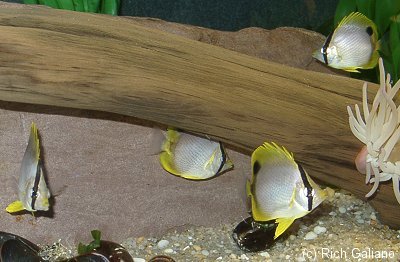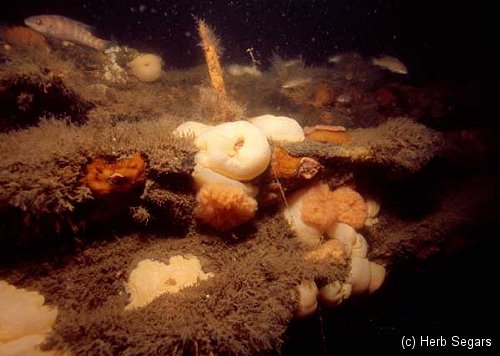Aquarium Guide - Temperature
Tropical Aquaria
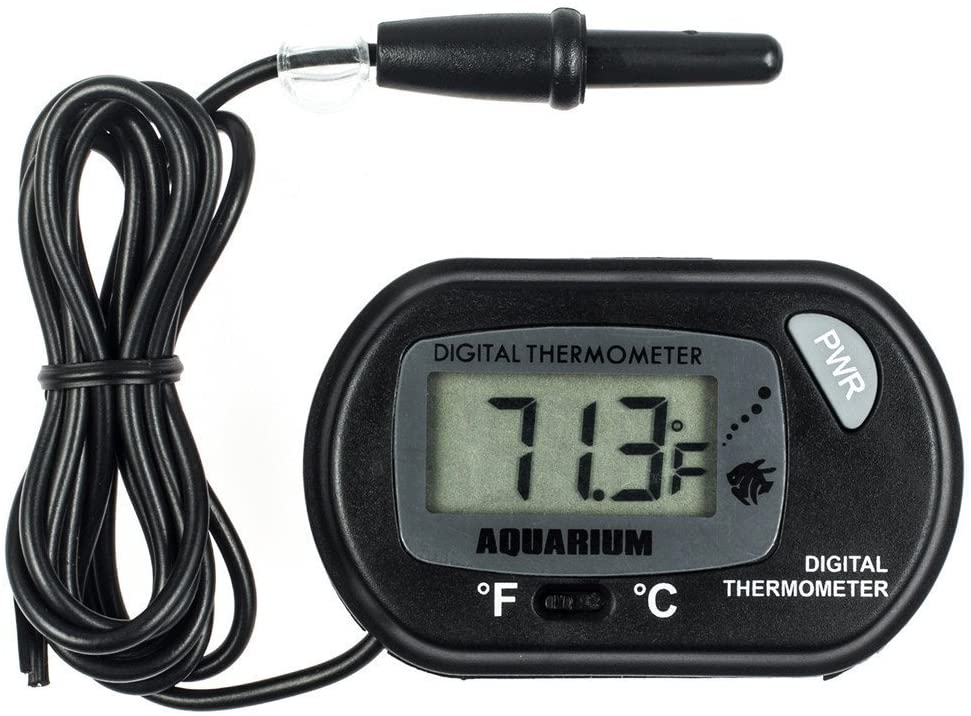
Tropical aquaria should generally be maintained at 75-80°F. In hot weather, temperatures up to 85°F are easily tolerated as long as adequate aeration is maintained. The addition of an air stone and a small air pump during these periods is helpful. At 90 F things start to get dangerous, and the tank should be cooled by floating ice packs or blocks of ice in it. Temperatures down to 70°F will generally do little harm, but the fish will be uncomfortable, and the temperature should be raised. Below 65°F is again dangerous for tropical fishes.
For freshwater tropical aquaria, a simple tube-type electrical heater should suffice for the winter. In the summer no heater is necessary, and typically your home air conditioning will keep the aquarium within acceptable temperatures during hot spells. Having bought a good heater, you should also get an inexpensive suction cup type mount for the free end. This will stand it away from the glass, and also prevent big fish from smashing it. It doesn't hurt to have a cheap spare heater for backup either.
Coldwater Aquaria
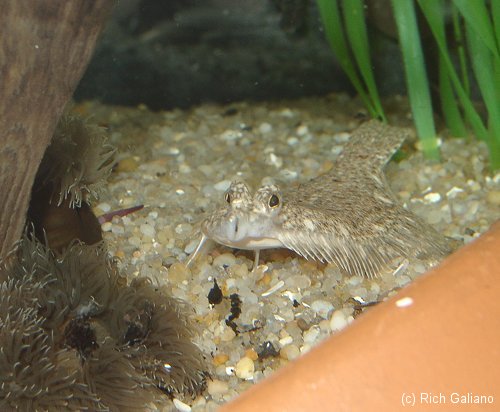
For local creatures, tolerable summer water temperatures range in the upper 60's to low 70's in the ocean, somewhat more variable in freshwater bodies. Coldwater aquaria should therefore be maintained no warmer than 75°F, preferably lower. Since winter water temperatures go right down to freezing, any temperature that does not form solid ice is acceptable in the winter. Extremely cold temperatures are not necessary in the winter, but their absence may throw off reproductive patterns that are keyed to the seasons.
In the winter maintaining an acceptable coldwater temperature range is not usually a problem unless you keep your home unusually warm, but in the summer this can be difficult. If you have a consistently cool basement, then set up the tank there. Another alternative is to put the tank in a small room with an air conditioner, but this can run up some very large electricity bills. The best solution is to use an aquarium chiller.
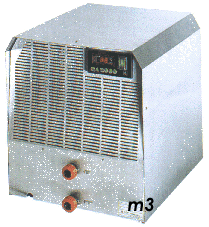
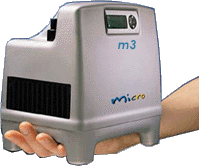
An aquarium chiller is a purpose-built cooling unit that directly cools the water in the aquarium. The two common types are in-line and in-tank. An in-line chiller resides outside the tank and is plumbed into the external filter system, utilizing existing pumps and water hoses for circulation. An in-tank chiller places the cooling element inside the tank, connected to the rest of the unit outside by flexible coolant hoses. Both are thermostat-controlled.
The Italian-made chillers pictured worked very well, for a while. Unfortunately, they were impossible to maintain, as parts are simply unavailable. Compare that with say Eheim (Germany), for which parts are readily available. I have twenty-year-old Eheim filters that are still running. Chinese equipment is also typically unmaintainable, but it is also inexpensive. Italian imports are a bad combination of expensive and disposable, and this goes for everything from kitchen appliances to automobiles. And my last name ends in an 'o', so don't go accusing me of being prejudiced - this is simply the fact.
Most chillers are similar in design and operation to Freon-based air conditioners ( in fact, it is possible to convert an old air conditioner for this purpose. ) At the very smallest end of the range are a number of models that operate purely thermo-electrically. These have no Freon or moving parts, except for a single, easily replaced cooling fan, and are very quiet and energy-efficient. The size and type of chiller you will need will depend on the size of the aquarium and the expected temperature "draw-down".
For maximum efficiency when using a chiller, insulate everything you can - the bottom, back, and sides of the aquarium, any external filters, and especially all water hoses. Also, try to minimize external heat loads. Ultimately, all the power used by a water pump or filter is dissipated into the tank as heat. Therefore, a filter pump that draws 10 watts is equivalent to a 10-watt heater running all the time. There is not much you can do about this, except try not to use excessively large pumps. Another heat load is the lighting. If a light draws 30 watts and 1/3 of that is dissipated into the tank, that is again equal to a 10-watt heater. One way to decrease the heat load of a typical aquarium hood light is to cut ventilation holes in the back of the housing and in the top of the reflector so that a cooling current of air can flow through the unit and draw away the heat. Most hoods already have cooling vents in the top, but these are useless if the unit is otherwise sealed. Other heat loads can include UV sterilizers and ozone generators.
Temperature Measurements
I now use only digital electronic thermometers. A simple model with a waterproof wired probe costs $10-$15 and is accurate to +/- 1°F, and precise to +/- 0.1°F, which is useful for detecting trends in water temperature. The big display is readable from across the room, and the probe can easily be moved around to any desired location.
Temperature Changes
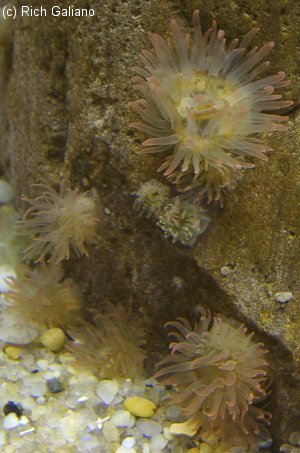
The key to changing water temperature is to do it slowly and in small steps. The main danger is in over-adjusting the temperature control and cooking or chilling the tank. Many small changes are safer than one big one. On a test-tube type heater with a knob control on the top, never make no more than a quarter turn at a time, without waiting 15-20 minutes for the system to stabilize. The fully submerged thermostat-type heaters theoretically never need to be adjusted, as long as they hold their calibration.
Emergencies
Electrical blackouts can be lethal, as both the filter and heater/chiller will go out. If it is not possible to warm/cool the room by some other means, then cover the tank with a blanket. If the tank gets too warm/cool and you still have hot/cold water at the tap ( or ice ), try fashioning a hot/cold water bottle from a plastic bag and floating it in the tank, but don't just pour hot water into the tank. When necessary, ice can be floated directly in a freshwater aquarium, or in a plastic bag in a marine aquarium, to avoid diluting the tank with meltwater.
Why Worry ?
Excessively high temperatures are dangerous to fish and other aquarium inhabitants because the oxygen levels in the water decrease with increased temperature, while at the same time the fish's oxygen requirements actually increase. A rule of thumb is that for any cold-blooded animal, the metabolic rate roughly doubles for every 10°C ( 18°F. ) Thus, a cold-blooded organism will require twice as much oxygen at 77°F as it would at 59°F, while at the same time, the available oxygen has dropped by approximately 20% ( likely more. ) Many aquatic creatures ( fishes especially ) are capable of greatly varying their respiration rate to adjust to a range of temperatures and oxygen levels.
Dissolved Oxygen |
|||||
Temperature |
Freshwater |
Saltwater 35deg |
|||
| deg C | deg F | saturated (100%) |
minimum healthy | saturated (100%) |
minimum healthy |
| 0 | 32 | 14.6 mg/l | 41% | 11.7 mg/l | 47% |
| 5 | 41 | 12.8 mg/l | 47% | 10.4 mg/l | 52% |
| 10 | 50 | 11.3 mg/l | 53% | 9.3 mg/l | 58% |
| 15 | 59 | 10.1 mg/l | 59% | 8.5 mg/l | 65% |
| 20 | 68 | 9.1 mg/l | 66% | 7.8 mg/l | 71% |
| 25 | 77 | 8.2 mg/l | 73% | 7.1 mg/l | 77% |
| 30 | 86 | 7.5 mg/l | 80% | 6.5 mg/l | 85% |
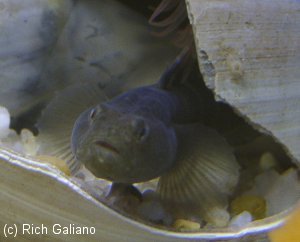
Low temperatures are dangerous to tropical fish because they become more susceptible to shock, parasites, and disease. Much literature is devoted to the exact temperature at which each species should be maintained. This is bunk, most fish don't care that much, and the guidelines above are generally adequate. Most fish can also take a quick 2-3°F temperature change in stride, but not a lot more. Just think about how much control they have over their water temperature in the wild.
- Tank
- Water
- Temperature
- Filtration
- Lighting

